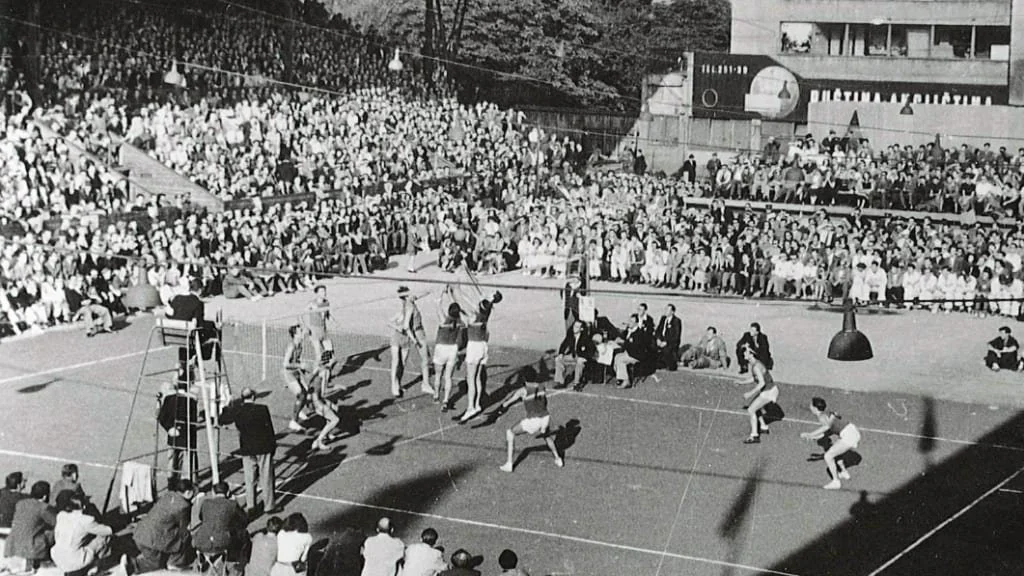The Rise of Men’s Volleyball on the International Stage
When I boarded a plane recently to watch the FIVB Men’s World Championship in the Philippines, I didn’t realize I’d be stepping right into a wave that’s been building for years—the rise of men’s volleyball on the world stage. Sitting in the stands at the FIVB tournament, surrounded by flags, chants, and fans from every corner of the globe, it hit me: something big is happening in men’s volleyball.
For decades, volleyball has been a sport dominated by the women’s side, at least in terms of visibility and mainstream attention. And that’s not just my impression—it’s backed by numbers.
A Quick History Lesson
The international stage for volleyball has been set for quite some time. The FIVB Men’s World Championship was first played in 1949, with the women’s following closely behind in 1952. But while the two competitions launched just three years apart, their trajectories have been different.
First FIVB Championship in Prague
In many countries—think Brazil, Japan, China, Cuba, and Italy—women’s volleyball became the face of the sport. Universities and schools built deep pipelines of women athletes, while federations put their resources into creating powerhouse programs. The result? Women’s volleyball was often easier to watch, better funded, and more widely celebrated.
Fast Forward to Today: Where the Numbers Stand
So, how do things stack up now? Let’s look at the data:
At the Volleyball Nations League (VNL) 2024, women’s matches actually sold out faster. Attendance for the women’s finals rose 41% year over year, with some venues hitting an 84% sell-out rate. Men’s matches weren’t far behind though, with a 9% increase in attendance and 78% sell-out rate.
On streaming and broadcast platforms, women’s matches often have the edge. For example, the women’s finals on VBTV became the most-watched game of the year. But men’s volleyball is catching fire in certain regions—Poland’s VNL men’s finals gave Polsat Sport its biggest volleyball audience in 25 years.
In China, the 2025 Women’s World Championship pulled in a jaw-dropping 1.1 billion views across broadcast and digital platforms. That’s tough to beat! Still, men’s competitions are showing major gains, with tournaments generating tens of millions of social media engagements globally.
On social media overall, volleyball is thriving. The official “Volleyball World” channels have 16 million followers and growing, with men’s highlight clips getting shared at nearly the same rate as women’s.
Why Men’s Volleyball Was “Behind”
It’s fair to ask: why did men’s volleyball lag behind women’s for so long? A few reasons stand out:
Cultural focus: In many countries, women’s volleyball programs had more institutional support earlier.
Broadcast priorities: Media networks leaned into women’s games, which often had established stars and rivalries.
Tradition: Once the women’s side had the spotlight, it reinforced itself year after year.
But the tide is turning. The men’s game brings explosive athleticism—sky-high verticals, lightning-fast spikes, and powerful serves—that translate beautifully to highlight reels and digital content. As more fans discover men’s volleyball on streaming platforms, the demand is growing.
A Future in Motion
If you ask me where this is headed, I’d say we’re on the cusp of parity. Here’s why:
Streaming levels the field: No more waiting for TV broadcasts. Fans can follow men’s volleyball directly on apps and YouTube, where international highlights rack up millions of views.
Rising stars: Just like women’s volleyball has long had its legends, men’s volleyball is now producing global names that inspire new fans.
Global expansion: More countries are investing in their men’s teams. That means better competition, broader fan bases, and more stories for fans to rally behind.
From My Seat in the Stands
Traveling to watch the Philippines being represented on the global stage reminded me why these shifts matter. It’s not just about numbers on a screen—it’s about the athletes who finally have a bigger stage to shine on, the parents flying halfway across the world to watch, and the fans who are finding a new passion in men’s volleyball. My son has had the privilege to train with this Philippine National Team under the coaching of Olympic winning Angiolino Frigoni.
As the chants echoed in the FIVB arena, I thought about how different the sport feels compared to when I was younger. Women’s volleyball will always have its rich history and passionate base—but the men’s side is no longer a step behind. It’s rising rapidly. And now, with the Philippine National Team leaping to the No. 19 spot in the world, this is only the beginning and I’m glad I get a front-row seat to watch it happen.
XOXO- STYLE Nation
Sources:
FIVB Women’s World Championship history (since 1952):
en.volleyballworld.com – Women’s World Championship 70 Years of HistoryVNL 2024 global record-breaking viewership & attendance (41% increase women’s, 9% men’s):
fivb.com – VNL 2024 Concludes with Record-Breaking Global Viewership and AttendanceVolleyball breaks records at the 2025 Women’s World Championship (1.1 billion views in China):
en.volleyballworld.com – Volleyball Breaks Records at the FIVB Women’s World Championship 2025Men’s volleyball in Poland – Polsat Sport’s biggest volleyball audience in 25 years:
fivb.com – VNL 2025 Men’s Finals Deliver Polsat Sport’s Biggest Audience in 25 YearsVolleyball World’s social media reach & growth (16 million followers, top on YouTube/X):
en.volleyballworld.com – Volleyball World Claims Gold in SportOnSocial League Table 2024Volleyball World social stats & engagements (40 million fans reached, 1.5M engagements):
fivb.com – Volleyball World Tops SportOnSocial League Table 2023FIVB leading charge for gender equality in volleyball:
fivb.com – FIVB Leading the Charge for Gender Equality








